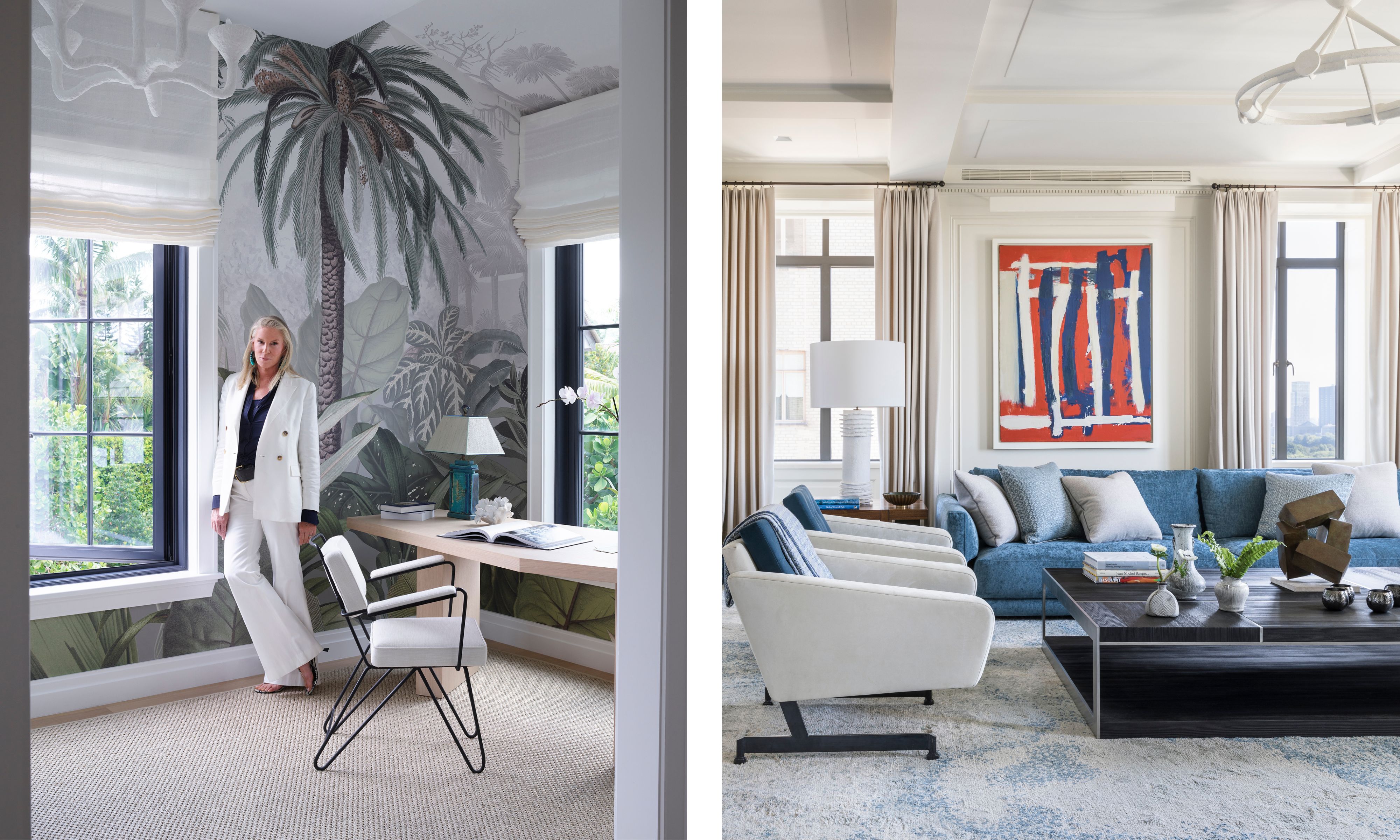Layered Lives: ‘You Have to Be Open to the Possibilities and Bring a Sense of Fun to Everything You Do’ – Victoria Hagan Knows How to Create Spaces That Make People Feel Good
In our series Layered Lives, we get to know the designer behind her elegant and perfectly proportioned spaces, finding out more about Victoria's very collaborative approach to interior design

Few interior designers have shaped modern American style as profoundly as Victoria Hagan. For over three decades, the New York–based designer has been revered for interiors that marry sophistication with ease – elegant, beautifully balanced spaces that feel entirely personal to the people who live in them. Her instinct for scale, proportion, and purity of line has earned her a devoted global following, a shelf of design awards, and a place among the most influential names in the industry.
And she is going from strength to strength, having just completed the Armani building in New York, a haven of pale woods and sleek finishes. But Victoria's success is rooted in something far more instinctive than accolades – a lifelong, almost intuitive passion for design. From childhood memories of mentally redesigning rooms to career-defining commissions for leading collectors, she has always been driven by a deep sensitivity to how a space feels.
Here, in our monthly Layered Lives feature, she opens up about the creative instincts that guide her, the turning moments that defined her career, and the joy – and responsibility – of designing homes that truly make people feel good.

Homes & Gardens: How did you first get interested in design?
I was born that way. From my earliest days, design has fascinated me. I have actual memories of standing in my crib and thinking about the floor finish and what I would have done – no, seriously! I remember being in my stroller and wondering why they selected certain flowers that I could see instead of other flowers that I would have chosen. I was honestly born this way – and it's a blessing and a curse. I'm very sensitive to colors and solving decor problems.
Homes & Gardens: What are the blessings of having this sort of mindset?
That I get to help people with their homes. You get to make spaces that make people feel good, and that makes me feel good. I love the collaborative nature of the work I do. Meanwhile, the curse is that I'm passionate about it – too passionate – and I really do care about my clients and their projects. I spend my whole life thinking about them, often waking up in the night with a new way to troubleshoot something that is going wrong.
Design expertise in your inbox – from inspiring decorating ideas and beautiful celebrity homes to practical gardening advice and shopping round-ups.
Homes & Gardens: Who or what were some of your early design influences?
My grandmother loved to sew, and she would take us shopping for fabrics and to make us dresses. I was fascinated by the level of detail she'd drawn on to make beautiful red velvet dresses with lace collars. She used to talk to me about handmade lace, and let me select the buttons, and it was my favorite thing to do.

Homes & Gardens: Were there any places that inspired you, too?
My mother was a fashion illustrator, and she would take us to museums in New York. We would sit in the cafeteria of the Metropolitan Museum of Art, a beautiful luncheonette with a big fountain, huge white light fixtures that Dorothy Draper had designed, and the juxtaposition of the scale of these lights and the water feature was brilliant. I’ve always taken note of how a space makes you feel and what in that space it is that makes you feel that way. A lot of times, it's the unpredictable, and you have to be open to the possibilities and bring a sense of fun to everything you do.
Homes & Gardens: What sums up “home” to you?
It's a place where I keep my favorite things. I like to collect and decorate with vintage pieces – when I was 16, I took my birthday money and bought a set of vintage broth cups. I bet there are not many 16-year-olds doing that! But I still have them and I still love them. I pulled them out to serve dessert in the other night and they made me so happy. I've been collecting my whole life – just anything I love, and I just know that I have to have it when I see it. I love to travel. My first solo trip abroad was to London when I was in design school, and we went shopping. It opened my eyes to finding pieces that are personal and have character and soul.
Homes & Gardens: Why is collecting so important to you?
It's nice to own things that bring back memories of travel or special moments, those connections to the past. When I look at my collections, I feel comfortable. And having a home that can do that is what life should be all about.

Homes & Gardens: What other ways can you make a home feel comfortable?
Making people feel comfortable is part of my secret sauce! Each space I design for my clients is so personal and all about collaboration with that person. I like to really go on a journey with them and figure out what it is that makes them feel good, what moment of their day, or what hobby, or what color. And then find ways to fold that into the design.
Homes & Gardens: Which project felt like a turning point in your career?
When I look back on my career, there is one moment that stands out as just this. I was recently married, and I got a call from Ronald Perlman's office. He was a big financier, and they wanted me to work on his house in Palm Beach. The catch was that they needed it done very quickly. I was like, ‘I'm not sure you understand, it takes a while to design a house,’ and they said, ‘We do understand, but you were recommended because you can do it. And if you can't, we'll find someone who can.’ Well! I love a challenge, and so I thought I'd better just find a way to make it work.
It was so exciting because it was a historical home and he had an amazing art collection. It was the first time I could hang a huge Hockney over a couch covered in Fortuny fabric, while playing with period pieces and giving the house a great energy. You knew you were in Palm Beach and the breeze was blowing, but I introduced a notion of informality that people in the area weren't familiar with. I slipcovered his couches, which was quite revolutionary for the time! And his friends saw it, and then they called me, changing the trajectory of my career, I'm sure.

Homes & Gardens: What did you learn from that project?
It opened up a whole world to me, showing me that I could push clients a little bit and create something special. But I always know when I'm about to push too far and it's time to pull back!
Homes & Gardens: How do you know how far you can push the design process?
You have to be very aware, keeping your eyes open and listening to everything – not just what is said by the clients but what is not said. Trust your instincts. I know when clients are happy and comfortable, so it’s taking all these observations and making decisions along the way to keep them like that.
Homes & Gardens: Outside of interiors, what fuels your creativity?
Art, fashion, traveling, living, just seeing new spaces – just being out in the world. When I was in design school, a professor said to me, 'Do you understand that with everything you see around you, someone made a decision about it,' and it was such an eye-opening thing to hear. Our environment has been designed by so many people – not always well, I might add! – and I respond to what people are doing and what decisions they’re making. I absolutely love to see something new on the runway; it makes you think about the possibilities. There was that recent Chanel show that had a girl with an amazing skirt, and I was so inspired. I need to do to drapery what they did to that skirt.

Homes & Gardens: What advice do you have for young designers?
Listen to your heart and listen to yourself. Design is a profession like anything else; it's not all instinct. If you are open to learning, then you will learn every day – I always do. You might have mastered scale or color, but design is more creative than just an algorithm. You have to raise the bar and open your imagination, and never try to be the same as someone else. Just be true to yourself.
Layered Lives is Homes & Gardens’ in-depth interview series with iconic creatives, where conversations delve far beyond the surface. We explore the memories, possessions, and passions that shape their aesthetic – revealing the personal stories and experiences that inform their work. Each feature is a richly layered portrait of life as well as design, offering you a glimpse into the minds and lives of the people behind the rooms we admire.
Pip Rich is an interiors journalist and editor with 20 years' experience, having written for all of the UK's biggest titles. Most recently, he was the Global Editor in Chief of our sister brand, Livingetc, where he now continues in a consulting role as Executive Editor. Before that, he was acting editor of Homes & Gardens, and has held staff positions at Sunday Times Style, ELLE Decoration, Red and Grazia. He has written three books – his most recent, A New Leaf, looked at the homes of architects who had decorated with house plants. Over his career, he has interviewed pretty much every interior designer working today, soaking up their knowledge and wisdom so as to become an expert himself.

